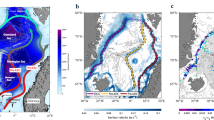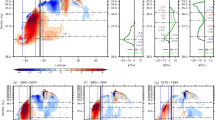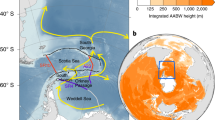Abstract
The abyssal limb of the global Meridional Overturning Circulation redistributes heat and carbon as it carries Antarctic Bottom Water from the Southern Ocean towards the Northern Hemisphere. Using mooring observations and hydrographic data from multiple sources in the North Atlantic, we show that northward-flowing Antarctic Bottom Water is constrained below 4,500 m with a mean volume transport of 2.40 ± 0.25 Sv at 16° N. We find that during 2000–2020, the Antarctic Bottom Water northward transport weakened by approximately 0.35 ± 0.13 Sv, corresponding to a 12 ± 5% decrease. The weakening of the Atlantic Meridional Overturning Circulation abyssal cell is a probable response to reduced Antarctic Bottom Water formation rates over the past several decades and is associated with abyssal warming observed throughout the western Atlantic Ocean. We estimate that the warming of the Antarctic Bottom Water layer in the subtropical North Atlantic is, on average, 1 m°C per year in the last two decades due to the downward heaving of abyssal isopycnals, contributing to the increase of abyssal heat content and, hence, sea-level rise in the region (1 m°C = 0.001 °C). This warming trend is approximately half of the Antarctic Bottom Water warming trend observed in the South Atlantic and parts of the Southern Ocean, indicating a dilution of the signal as the Antarctic Bottom Water crosses the Equator.
This is a preview of subscription content, access via your institution
Access options
Access Nature and 54 other Nature Portfolio journals
Get Nature+, our best-value online-access subscription
$29.99 / 30 days
cancel any time
Subscribe to this journal
Receive 12 print issues and online access
$259.00 per year
only $21.58 per issue
Buy this article
- Purchase on Springer Link
- Instant access to full article PDF
Prices may be subject to local taxes which are calculated during checkout




Similar content being viewed by others
Data availability
All data used in this study are freely available and can be accessed as follows: MOVE (link for the OceanSITES Global Data Assembly Center Public FTP Server can be found at https://mooring.ucsd.edu/move/ (ref. 72)); GAGE (https://doi.org/10.17604/5jd9-7f77 (ref. 73)); WOCE and GOSHIP A05 line (https://cchdo.ucsd.edu/ (ref. 74)); RAPID (https://www.bodc.ac.uk/data/bodc_database/nodb/ (ref. 75)); Deep Argo (https://doi.org/10.17882/42182 (ref. 76)); WBTS (link for the AOML-NOAA’s public FTP server can be found at https://www.aoml.noaa.gov/phod/wbts/data.php (ref. 77)); WOA18 (https://www.ncei.noaa.gov/data/oceans/woa/WOA18/DATA/ (ref. 78)); GEBCO (https://www.gebco.net/data_and_products/gridded_bathymetry_data/ (ref. 55).
Code availability
All the codes used in this study are freely available in public repositories. As mentioned in Methods, all relevant seawater parameters, properties and dynamic height were computed using the Python Gibbs Seawater Oceanographic 3.4.2 software available at https://www.teos-10.org/software.htm#1. The γn routine can be found at http://www.teos-10.org/preteos10_software/gamma_GP.html. The Python pyMannKendall software for the MK trends statistical tests is available at https://github.com/mmhs013/pyMannKendall/tree/v1.1. Finally, all data handling, mathematical operations, data interpolation and data filtering procedures were performed using standard functions found in the Xarray 0.20.1 (https://docs.xarray.dev/en/stable/), Numpy 1.21.5 (https://numpy.org/) and Scipy 1.7.3 (https://scipy.org/) Python 3 packages.
References
Orsi, A. H., Johnson, G. C. & Bullister, J. L. Circulation, mixing, and production of Antarctic Bottom Water. Prog. Oceanogr. 43, 55–109 (1999).
Lumpkin, R. & Speer, K. Global ocean meridional overturning. J. Phys. Oceanogr. 37, 2550–2562 (2007).
Johnson, G. C. Quantifying Antarctic Bottom Water and North Atlantic Deep Water volumes. J. Geophys. Res. 113, C05027 (2008).
Johnson, G. C. et al. Global oceans: ocean heat content. Bull. Am. Meteorol. Soc. 99, Si–S310 (2018).
Bagnell, A. & DeVries, T. 20th century cooling of the deep ocean contributed to delayed acceleration of Earth’s energy imbalance. Nat. Commun. 12, 4604 (2021).
Purkey, S. G. & Johnson, G. C. Warming of global abyssal and deep Southern Ocean waters between the 1990s and 2000s: contributions to global heat and sea level rise budgets. J. Climate 23, 6336–6351 (2010).
Kouketsu, S. et al. Deep ocean heat content changes estimated from observation and reanalysis product and their influence on sea level change. J. Geophys. Res. 116, C03012 (2011).
Zenk, W. & Morozov, E. Decadal warming of the coldest Antarctic Bottom Water flow through the Vema Channel. Geophys. Res. Lett. 34, L14607 (2007).
Johnson, G. C., Purkey, S. G. & Toole, J. M. Reduced Antarctic meridional overturning circulation reaches the North Atlantic Ocean. Geophys. Res. Lett. 35, L22601 (2008).
Desbruyères, D. G., Purkey, S. G., McDonagh, E. L., Johnson, G. C. & King, B. A. Deep and abyssal ocean warming from 35 years of repeat hydrography. Geophys. Res. Lett. 43, 10,356–10,365 (2016).
Menezes, V. V., Macdonald, A. M. & Schatzman, C. Accelerated freshening of Antarctic Bottom Water over the last decade in the southern indian ocean. Sci. Adv. https://doi.org/10.1126/sciadv.1601426 (2017).
Purkey, S. G. et al. Unabated bottom water warming and freshening in the South Pacific ocean. J. Geophys. Res.: Oceans 124, 1778–1794 (2019).
Johnson, G. C., Purkey, S. G., Zilberman, N. V. & Roemmich, D. Deep Argo quantifies bottom water warming rates in the southwest Pacific Basin. Geophys. Res. Lett. 46, 2662–2669 (2019).
Strass, V. H., Rohardt, G., Kanzow, T., Hoppema, M. & Boebel, O. Multidecadal warming and density loss in the deep Weddell Sea, Antarctica. J. Climate 33, 9863–9881 (2020).
Johnson, G. C. Antarctic Bottom Water warming and circulation slowdown in the Argentine Basin from analyses of deep Argo and historical shipboard temperature data. Geophys. Res. Lett. https://doi.org/10.1029/2022GL100526 (2022).
van Wijk, E. M. & Rintoul, S. R. Freshening drives contraction of Antarctic Bottom Water in the Australian Antarctic Basin. Geophys. Res. Lett. 41, 1657–1664 (2014).
Purkey, S. G. & Johnson, G. C. Global contraction of Antarctic Bottom Water between the 1980s and 2000s. J. Clim. 25, 5830–5844 (2012).
Masuda, S. et al. Simulated rapid warming of abyssal North Pacific waters. Science 329, 319–322 (2010).
Nakano, H. & Suginohara, N. Importance of the eastern Indian Ocean for the abyssal Pacific. J. Geophys. Res.: Oceans 107, 3219 (2002).
Patara, L. & Böning, C. W. Abyssal ocean warming around Antarctica strengthens the Atlantic overturning circulation. Geophys. Res. Lett. 41, 3972–3978 (2014).
Khatiwala, S., Primeau, F. & Holzer, M. Ventilation of the deep ocean constrained with tracer observations and implications for radiocarbon estimates of ideal mean age. Planet. Sci. Lett. 325–326, 116–125 (2012).
Solodoch, A. et al. How does Antarctic Bottom Water cross the Southern Ocean? Geophys. Res. Lett. https://doi.org/10.1029/2021GL097211 (2022).
Silvano, A. et al. Observing Antarctic Bottom Water in the Southern Ocean. Front. Mar. Sci. https://doi.org/10.3389/fmars.2023.1221701 (2023).
Campos, E. J. D. et al. Warming trend in Antarctic Bottom Water in the Vema Channel in the South Atlantic. Geophys. Res. Lett. https://doi.org/10.1029/2021GL094709 (2021).
Li, Q., England, M. H., Hogg, A. M., Rintoul, S. R. & Morrison, A. K. Abyssal ocean overturning slowdown and warming driven by Antarctic meltwater. Nature 615, 841–847 (2023).
Frajka-Williams, E., Cunningham, S. A., Bryden, H. & King, B. A. Variability of Antarctic Bottom Water at 24.5° N in the Atlantic. J. Geophys. Res.: Oceans https://doi.org/10.1029/2011JC007168 (2011).
Desbruyères, D., McDonagh, E. L., King, B. A. & Thierry, V. Global and full-depth ocean temperature trends during the early twenty-first century from Argo and repeat hydrography. J. Clim. 30, 1985–1997 (2017).
Schmitz, W. J. & McCartney, M. S. On the North Atlantic circulation. Rev. Geophys. 31, 29–49 (1993).
Talley, L. D., Pickard, G. L., Emery, W. J. & Swift, J. H. Descriptive Physical Oceanography: An Introduction 6th edn (Academic Press, 2011).
Herrford, J., Brandt, P. & Zenk, W. Property changes of deep and bottom waters in the western tropical Atlantic. Deep Sea Res. Part I 124, 103–125 (2017).
Cunningham, S. A. & Alderson, S. Transatlantic temperature and salinity changes at 24.5° N from 1957 to 2004. Geophys. Res. Lett. https://doi.org/10.1029/2007GL029821 (2007).
Johnson, G. C., Cadot, C., Lyman, J. M., McTaggart, K. E. & Steffen, E. L. Antarctic Bottom Water warming in the Brazil Basin: 1990s through 2020, from WOCE to Deep Argo. Geophys. Res. Lett. https://doi.org/10.1029/2020GL089191 (2020).
Johnson, G. C., Robbins, P. E. & Hufford, G. E. Systematic adjustments of hydrographic sections for internal consistency. J. Atmos. Oceanic Technol. 18, 1234–1244 (2001).
Wright, W. R. Northward transport of Antarctic Bottom Water in the western Atlantic Ocean. Deep Sea Res. 17, 367–371 (1970).
Mauritzen, C., Polzin, K. L., McCartney, M. S., Millard, R. C. & West-Mack, D. E. Evidence in hydrography and density fine structure for enhanced vertical mixing over the Mid-Atlantic Ridge in the western Atlantic. J. Geophys. Res. 107, 3147 (2002).
Kanzow, T. Monitoring the Integrated Deep Meridional Flow in the Tropical North Atlantic. Ph.D. thesis, Christian-Albrechts Universität Kiel (2004).
Spall, M. A. Wave-induced abyssal recirculations. J. Mar. Res. 52, 1051–1080 (1994).
Biló, T. C. & Johns, W. E. The Deep Western Boundary Current and adjacent interior circulation at 24°–30° N: mean structure and mesoscale variability. J. Phys. Oceanogr. 50, 2735–2758 (2020).
Kanzow, T., Send, U., Zenk, W., Chave, A. D. & Rhein, M. Monitoring the integrated deep meridional flow in the tropical North Atlantic: long-term performance of a geostrophic array. Deep Sea Res. Part I 53, 528–546 (2006).
Limeburner, R., Whitehead, J. A. & Cenedese, C. Variability of Antarctic Bottom Water flow into the North Atlantic. Deep Sea Res. Part II 52, 495–512 (2005).
Desbruyères, D. G. et al. Warming-to-cooling reversal of overflow-derived water masses in the Irminger Sea during 2002–2021. Geophys. Res. Lett. 49, 1–10 (2022).
Zhou, S. et al. Slowdown of Antarctic Bottom Water export driven by climatic wind and sea-ice changes. Nat. Clim. Change 13, 701–709 (2023).
Meredith, M. P., Garabato, A. C. N., Gordon, A. L. & Johnson, G. C. Evolution of the deep and bottom waters of the Scotia Sea, Southern Ocean, during 1995–2005*. J. Clim. 21, 3327–3343 (2008).
Meinen, C. S., Perez, R. C., Dong, S., Piola, A. R. & Campos, E. J. D. Observed ocean bottom temperature variability at four sites in the northwestern Argentine Basin: evidence of decadal deep/abyssal warming amidst hourly to interannual variability during 2009–2019. Geophys. Res. Lett. https://doi.org/10.1029/2020GL089093 (2020).
Polzin, K. L., Toole, J. M., Ledwell, J. R. & Schmitt, R. W. Spatial variability of turbulent mixing in the abyssal ocean. Science 276, 93–96 (1997).
St Laurent, L. C. & Thurnherr, A. M. Intense mixing of lower thermocline water on the crest of the Mid-Atlantic Ridge. Nature 448, 680–683 (2007).
Send, U., Kanzow, T., Zenk, W. & Rhein, M. Monitoring the Atlantic Meridional Overturning Circulation at 16° N. CLIVAR Exch. 7, 31–33 (2002).
Kanzow, T., Send, U. & McCartney, M. On the variability of the deep meridional transports in the tropical North Atlantic. Deep Sea Res. Part I 55, 1601–1623 (2008).
Johns, W. E. et al. Variability of shallow and deep western boundary currents off the Bahamas during 2004–05: results from the 26° N RAPID–MOC array. J. Phys. Oceanogr. 38, 605–623 (2008).
McCarthy, G. D. et al. Measuring the Atlantic Meridional Overturning Circulation at 26° N. Prog. Oceanogr. 130, 91–111 (2015).
Meinen, C. S. et al. Variability of the Deep Western Boundary Current at 26.5° N during 2004–2009. Deep Sea Res. Part II 85, 154–168 (2013).
Wong, A., Keeley, R., Carval, T. & the Argo Data Management Team Argo Quality Control Manual for CTD and Trajectory Data (Ifremer, 2023).
Locarnini, R. A. et al. World Ocean Atlas 2018, Vol. 1: Temperature NOAA Atlas NESDIS 81 (NOAA, 2018).
Zweng, M. M. et al. World Ocean Atlas 2018, Vol. 2: Salinity NOAA Atlas NESDIS 82 (NOAA, 2018).
GEBCO Compilation Group GBCO 2020 Grid (GEBCO, 2020).
McCartney, M. S., Bennett, S. L. & Woodgate-Jones, M. E. Eastward flow through the Mid-Atlantic Ridge at 11° N and its influence on the abyss of the eastern basin. J. Phys. Oceanogr. 21, 1089–1121 (1991).
Gupta, M. M. Numerical methods and software (David Kahaner, Cleve Moler, and Stephen Nash). SIAM Rev. 33, 144–147 (1991).
Johns, E., Watts, R. D. & Rossby, T. H. A test of geostrophy in the Gulf Stream. J. Geophys. Res. 94, 3211–3222 (1989).
Danabasoglu, G. et al. Revisiting AMOC transport estimates from observations and models. Geophys. Res. Lett. https://doi.org/10.1029/2021GL093045 (2021).
Send, U., Lankhorst, M. & Kanzow, T. Observation of decadal change in the Atlantic meridional overturning circulation using 10 years of continuous transport data. Geophys. Res. Lett. https://doi.org/10.1029/2011GL049801 (2011).
Akima, H. A new method of interpolation and smooth curve fitting based on local procedures. J. ACM 17, 589–602 (1970).
Bindoff, N. L. & Mcdougall, T. J. Diagnosing climate change and ocean ventilation using hydrographic data. J. Phys. Oceanogr. 24, 1137–1152 (1994).
Häkkinen, S., Rhines, P. B. & Worthen, D. L. Heat content variability in the North Atlantic Ocean in ocean reanalyses. Geophys. Res. Lett. 42, 2901–2909 (2015).
McDougall, T. J. & Barker, P. M. Getting Started with TEOS-10 and the Gibbs Seawater (GSW) Oceanographic Toolbox SCOR/IAPSO WG127 (Teos, 2011); http://www.teos-10.org/software.htm
Jackett, D. R. & McDougall, T. J. A neutral density variable for the world’s oceans. J. Phys. Oceanogr. 27, 237–263 (1997).
Emery, W. J. & Thomson, R. E. Data Analysis Methods in Physical Oceanography 3rd edn (Elsevier, 2001).
Biló, T. C., Straneo, F., Holte, J. & Le Bras, I. A. A. Arrival of new great salinity anomaly weakens convection in the Irminger Sea. Geophys. Res. Lett. 49, e2022GL098857 (2022).
Hussain, M. & Mahmud, I. pymannkendall: a Python package for non parametric Mann Kendall family of trend tests. J. Open Source Softw. https://doi.org/10.5281/zenodo.3347253 (2019).
Mann, H. Nonparametric tests against trend. Econometrica https://doi.org/10.2307/1907187 (1945).
Kendall, M. Rank Correlation Methods 4th edn (Charles Griffin, 1975).
Yue, S. & Wang, C. The Mann–Kendall test modified by effective sample size to detect trend in serially correlated hydrological series. Water Resour. Manage. 18, 201–218 (2004).
Send, U. & Lankhorst, M. Meridional overturning variability experiment. Univ. California San Diego https://mooring.ucsd.edu/move/ (2024).
Kanzow, T., Carrilho Bilo, T., Lankhorst, M. & Mauritzen, C. Guyana Abyssal Gyre Experiment (GAGE) current meter mooring ocean velocity records obtained between February 2000 and April 2002 at 16° N. Univ. of Miami Libraries https://doi.org/10.17604/5jd9-7f77 (2023).
WOCE and GOSHIP. CLIVAR and Carbon Hydrographic Data Office https://cchdo.ucsd.edu/ (2023).
RAPID. National Oceanography Centre https://www.bodc.ac.uk/data/bodc_database/nodb/ (2024).
Fumihiko, A. et al. Argo float data and metadata from Global Data Assembly Centre (Argo GDAC). SEANOE https://doi.org/10.17882/42182 (2024).
WBTS. NOAA/OAR AOML https://www.aoml.noaa.gov/phod/wbts/data.php (2024).
WOA18. NCEI https://www.ncei.noaa.gov/data/oceans/woa/WOA18/DATA/ (2019).
Acknowledgements
We thank the many scientists, engineers and mariners from many institutions worldwide who supported several projects that developed instruments and collected, processed and published the data we used in this work. That includes all CTD, Deep Argo and moored profiles. Without their collaboration and hard work, studies like this would not happen. We offer special thanks to M. Lankhorst and the MOVE team for providing the MOVE dataset, to the WBTS team (R. Smith, D. Volkov, R. Garcia, J. Hooper) for providing the WBTS mooring and CTD dataset, to C. Meinen, M. Harrison, D. Volkov, M. Le Henaff and L. Chomiak for the useful discussions. We also thank S.-K. Lee for reading the manuscript and providing useful comments. T.C.B., R.C.P. and S.D. gratefully acknowledge the funding from the National Oceanic and Atmospheric Administration (NOAA)’s Global Ocean Monitoring and Observing programme (FundRef number 100007298); NOAA’s Climate Program Office, Climate Observations and Monitoring and Climate Variability and Predictability programmes under NOFO NOAA-OAR-CPO-2021-2006389 with additional NOAA Atlantic Oceanographic and Meteorological Laboratory support. Support for W.J.’s participation in the research was provided by the US National Science Foundation under grants OCE-1332978 and OCE-1926008. T.K. is funded by the EU’s Horizon 2020 Research and Innovation Program under the grant agreement number 821001 (SO-CHIC) and therein is a contribution to its Work Packages 3 and 6. This study is further a contribution to the project T3 of the Collaborative Research Centre TRR 181 ‘Energy Transfers in Atmosphere and Ocean’ funded by the Deutsche Forschungsgemeinschaft (DFG, German Research Foundation; project number 274762653). This research was carried out in part under the auspices of the Cooperative Institute for Marine and Atmospheric Studies, a cooperative institute of the University of Miami and the National Oceanic and Atmospheric Administration (NOAA), cooperative agreement NA 20OAR4320472.
Author information
Authors and Affiliations
Contributions
T.C.B. led this study from the idea conception to the data analysis, results interpretation and paper writing. R.C.P. and S.D. contributed to the idea conception, results interpretation, discussion and paper preparation. W.J. and T.K. contributed to the data analysis, results interpretation and discussion and paper preparation.
Corresponding author
Ethics declarations
Competing interests
The authors declare no competing interests.
Peer review
Peer review information
Nature Geoscience thanks the anonymous reviewers for their contribution to the peer review of this work. Primary Handling Editor: Tom Richardson, in collaboration with the Nature Geoscience team.
Additional information
Publisher’s note Springer Nature remains neutral with regard to jurisdictional claims in published maps and institutional affiliations.
Extended data
Extended Data Fig. 1 MOVE data analysis showing that most of the vertical geostrophic shear variability below 4500 m at 16∘ N, ranging from interannual to decadal time scales, is driven primarily by density changes within the DWBC domain.
Curves represent the detrended eighteen-month low-passed filtered abyssal geostrophic shear time anomalies series averaged between 4500-5000 m discussed in Fig. 3.
Extended Data Fig. 2 MOVE potential temperature analysis showing the period after 2017 is characterized by colder temperatures than the previous years at 16∘ N (see blue arrows).
Curves represent the detrended eighteen-month low-passed filtered potential temperature time anomalies series averaged between 4500-5000 m.
Supplementary information
Supplementary Information
Supplementary Figs. 1–5, Discussion and Tables 1–5.
Rights and permissions
Springer Nature or its licensor (e.g. a society or other partner) holds exclusive rights to this article under a publishing agreement with the author(s) or other rightsholder(s); author self-archiving of the accepted manuscript version of this article is solely governed by the terms of such publishing agreement and applicable law.
About this article
Cite this article
Biló, T.C., Perez, R.C., Dong, S. et al. Weakening of the Atlantic Meridional Overturning Circulation abyssal limb in the North Atlantic. Nat. Geosci. (2024). https://doi.org/10.1038/s41561-024-01422-4
Received:
Accepted:
Published:
DOI: https://doi.org/10.1038/s41561-024-01422-4



